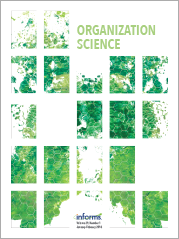Academic articles
Practitioner articles
Working papers
Books
Book chapters
Case studies
Other publications
Subject(s)
Economics, politics and business environment; Information technology and systems
Keyword(s)
online markets, price comparison websites, price dispersion, price competition, platforms, consumer search, consumer welfare
JEL Code(s)
L11, L86, D43
The large and growing industry of price comparison websites (PCWs) or “web aggregators” is poised to benefit consumers by increasing competitive pricing pressure on firms by acquainting shoppers with more prices. However, these sites also charge firms for sales, which feeds back to raise prices. I find that introducing any number of PCWs to a market increases prices for all consumers, both those who use the sites, and those who do not. I then use my framework to identify ways in which a more competitive environment could be achieved.
Volume
62
Journal Pages
1081–1110
ISSN (Online)
1468-2354
Subject(s)
Technology, R&D management
Keyword(s)
Selection, novelty, decision-making, innovation, panel
We examine how groups fall prey to the sequence effect when they make choices based on informed assessments of complex situations, for example, when evaluating research and development (R&D) projects. The core argument is that the temporal sequence of selection matters because projects that appear in a sequence following a funded project are themselves less likely to receive funding. Building on the idea that selecting R&D projects is a demanding process that drains participants’ mental and emotional resources, we further theorize the moderating effect of the influence of the timing of the panel meeting on the sequence effect. We test these conjectures using a randomization in sequence order from several rounds of R&D project selection at a leading professional service firm. We find robust support for the existence of a sequence effect in R&D as well as for the moderating effect. We further explore different explanations for the sequence effect and how it passes from the individual to the panel. These findings have broader implications for the literature on innovation and search in general and on group decision making for R&D, specifically, as they suggest that a previously overlooked dimension affects selection outcomes.
Copyright © 2021, The Author(s)
Volume
32
Journal Pages
987–1008
Subject(s)
Management sciences, decision sciences and quantitative methods; Strategy and general management
Keyword(s)
Reinforcing processes, quality, performance evaluation, movie industry, luck
When does market success indicate superior merit? We show that when consumer choices between products with equal prices depend on quality but also on past popularity, more popular products are not necessarily of higher quality. Rather, a medium level of popularity may be associated with lower quality than lower levels of popularity. Using a formal model we show that this kind of non-monotonic association occurs when reinforcing processes are strong. More generally, a dip can occur when outcomes depend on both quality and resources and the latter are allocated bimodally, with some being given a lot of resources and most receiving little. Empirically, we illustrate that such a dip occurs in the association between movie theater sales and ratings. The presence of a dip in the outcome-quality association complicates learning from market outcomes and evaluation of individuals and new ventures, challenges the legitimacy of stratification systems, and creates opportunities for sophisticated evaluators who understand the dip.
Copyright © 2021, The Author(s)
Volume
32
Journal Pages
1079–1099
Subject(s)
Economics, politics and business environment
Keyword(s)
Cartels, private damages, competition law
Private cartel damages litigation is on the rise in Europe since early 2000. This development has been initiated by the European courts and was supported by various policy initiatives of the European Commission, which found its culmination in the implementation of the EU Directive on Antitrust Damages end of 2016. This paper explores the impact of this reform process on effective compensation of damaged parties of cartel infringements. For that purpose we analyse all European cartel cases with a decision date between 2001 and 2015, for which we analyse litigation activity and speed. Overall, we find a substantial reduction of the time until first settlement (increase in litigation speed) together with a persisting high share of cases being litigated (high litigation activity). This supports the view that the reform not only increased the claimant’s expectation about the amount of damages being awarded, but also resulted in an alignment in the expectations of claimants and defendants in the final damages amount, i.e. the European Commission succeeded in reaching its objective to clarify and harmonize legal concepts across Europe.
Volume
9
Journal Pages
313–346
Subject(s)
Human resources management/organizational behavior
Keyword(s)
Crowdsourcing data analysis, scientific transparency, research reliability, scientific
robustness, researcher degrees of freedom, analysis-contingent results
robustness, researcher degrees of freedom, analysis-contingent results
In this crowdsourced initiative, independent analysts used the same dataset to test two hypotheses regarding the effects of scientists’ gender and professional status on verbosity during group meetings. Not only the analytic approach but also the operationalizations of key variables were left unconstrained and up to individual analysts. For instance, analysts could choose to operationalize status as job title, institutional ranking, citation counts, or some combination. To maximize transparency regarding the process by which analytic choices are made, the analysts used a platform we developed called DataExplained to justify both preferred and rejected analytic paths in real time. Analyses lacking sufficient detail, reproducible code, or with statistical errors were excluded, resulting in 29 analyses in the final sample. Researchers reported radically different analyses and dispersed empirical outcomes, in a number of cases obtaining significant effects in opposite directions for the same research question. A Boba multiverse analysis demonstrates that decisions about how to operationalize variables explain variability in outcomes above and beyond statistical choices (e.g., covariates). Subjective researcher decisions play a critical role in driving the reported empirical results, underscoring the need for open data, systematic robustness checks, and transparency regarding both analytic paths taken and not taken. Implications for organizations and leaders, whose decision making relies in part on scientific findings, consulting reports, and internal analyses by data scientists, are discussed.
With permission of Elsevier
Volume
165
Journal Pages
228–249
Subject(s)
Economics, politics and business environment; Information technology and systems; Technology, R&D management
Keyword(s)
AI, artificial intelligence, privay, data protection, information law
The European Commission has presented proposals for the horizontal regulation of artificial intelligence. It is thus foreseeable that the regulatory systems of data protection and IT security will be supplemented by a further cross-sectoral approach to the regulation of information technology. This article explains the proposals and describes their advantages and disadvantages.
[Die Europäische Kommission hat Vorschläge vorgelegt, wie eine horizontale Regulierung künstlicher Intelligenz erfolgen soll. Damit ist absehbar, dass neben die Regulierungssysteme des Datenschutzes und der IT-Sicherheit ein weiterer sektorübergreifender Ansatz zur Regulierung von Informationstechnik treten wird.]
[Die Europäische Kommission hat Vorschläge vorgelegt, wie eine horizontale Regulierung künstlicher Intelligenz erfolgen soll. Damit ist absehbar, dass neben die Regulierungssysteme des Datenschutzes und der IT-Sicherheit ein weiterer sektorübergreifender Ansatz zur Regulierung von Informationstechnik treten wird.]
Volume
45
Journal Pages
438–443
ISSN (Online)
1862-2607
ISSN (Print)
1614-0702
Subject(s)
Diversity and inclusion; Human resources management/organizational behavior
Keyword(s)
Random selection, diversity bonus, luck, decision biases, paradox of merit, learning traps
Complex tasks often cannot be addressed with expertise, but instead by assembling a diverse cognitive repertoire in teams. In such cases, engaging diversity may enhance performance. Yet various behavioral and social limits often deter organizations from recognizing or integrating valuable diversity. I argue that random selection is an undervalued tool for capturing the diversity bonus because it helps address (1) the paradox of merit, by avoiding fruitless deliberation; (2) biased reasoning, by deciding on the basis of no reason; and (3) learning traps, by discovering self-confirming false beliefs. More generally, incorporating random selection in organizational design can generate a less-is-more effect: deciding by blind luck means exercising less control over outcomes but achieving more by saving time and resources, as well as detecting and sanitizing biased reasons.
Volume
10
Journal Pages
85–91
ISSN (Online)
2245-408X
Subject(s)
Economics, politics and business environment; Information technology and systems; Technology, R&D management
Keyword(s)
Transatlantic, data protection, internet of things, artificial intelligence, industrial control systems (ICS)
Volume
2
Journal Pages
77–92
ISSN (Online)
2662-9739
ISSN (Print)
2662-9720
Subject(s)
Economics, politics and business environment
Keyword(s)
sunk cost effect, sunk cost fallacy, endowment effect, cognitive ability, fluid intelligence, crystallized intelligence, reflective thinking, online experiment, online survey, psychological scales, scale validation, Raven’s progressive matrices, international cognitive ability resource, cognitive reflection test, openness
JEL Code(s)
D91, C83, C90
We provide experimental evidence of behavior consistent with the sunk cost effect. Subjects who earned a lottery via a real-effort task were given an opportunity to switch to a dominant lottery; yet 23% chose to stick with their dominated lottery.The endowment effect accounts for roughly only one third of the effect. Subjects’ capacity for cognitive reflection is a significant determinant of sunk cost behavior.We also find stocks of knowledge or experience (crystallized intelligence) predict sunk cost behavior, rather than algorithmic thinking (fluid intelligence) or the personality trait of openness. We construct and validate a scale, the “SCE-8”, which encompasses many resources individuals can spend, and offers researchers an efficient way to measure susceptibility to the sunk cost effect.
Volume
186
Journal Pages
318–327
Subject(s)
Finance, accounting and corporate governance
Keyword(s)
Association tests, non-random sampling, equity, returns, distribution matching, multiple imputation, resampling
JEL Code(s)
M41
Volume
26
Journal Pages
772–814


